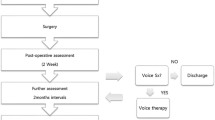Abstract
The objective of this study was to investigate the efficacy of early management of post-thyroidectomy unilateral vocal cord palsy (UVCP) and the clinical utility of the thyroidectomy-related voice questionnaire (TVQ) when planning UVCP treatment. The study group comprised 48 consecutive patients diagnosed with UVCP after thyroidectomy. Laryngoscopic examination and voice analysis were conducted, and the TVQ was administered pre-thyroidectomy and at 2 weeks and 1, 3, 6, and 12 months post-thyroidectomy. Twenty-five patients with aspiration symptoms and severe vocal difficulties received injection laryngoplasty, and 23 with no aspiration symptoms and relatively mild vocal difficulties underwent voice therapy. We performed a video fluoroscopic swallowing study on each patient 2 weeks after thyroidectomy and 1 month following the procedure. The average total TVQ scores 2 weeks post-thyroidectomy were 51.92 ± 11.42 in the injection laryngoplasty group and 35.78 ± 12.99 in the voice therapy group. Both subjective and objective parameters improved significantly at 1 month after treatment and continued to improve slowly over the next 12 months (p < 0.01) in both groups. TVQ scores were significantly lower in the injection laryngoplasty group than in the voice therapy group 1 month post-intervention (p < 0.01). At the study end point, the greatest improvement in subjective symptoms occurred in temporary VCP patients who underwent injection laryngoplasty. The optimal TVQ score cut-off distinguishing the two groups was 45 (68.0 % sensitivity, 78.3 % specificity). In conclusion, early management following timely diagnosis of post-thyroidectomy UVCP can improve symptoms within 1 month. Moreover, application of TVQ will aid clinicians to plan treatment for postoperative VCP patients.




Similar content being viewed by others
Referencess
Bhattacharyya N, Fried MP (2002) Assessment of the morbidity and complications of total thyroidectomy. Arch Otolaryngol Head Neck Surg 128:389–392
Roy AD, Gardiner RH, Niblock WM (1956) Thyroidectomy and the recurrent laryngeal nerves. Lancet 270:988–990
Rosenthal LHS, Benninger MS, Deeb RH (2007) Vocal fold immobility: a longitudinal analysis of etiology over 20 years. Laryngoscope 117:1864–1870
Dralle H, Sekulla C, Haerting J, Timmermann W, Neumann HJ, Kruse E, Grond S, Muhlig HP, Richter C, Voss J, Thomusch O, Lippert H, Gastinger I, Brauckhoff M, Gimm O (2004) Risk factors of paralysis and functional outcome after recurrent laryngeal nerve monitoring in thyroid surgery. Surgery 136:1310–1322
Holt GR, McMurray GT, Joseph DJ (1977) Recurrent laryngeal nerve injury following thyroid operations. Surg Gynecol Obstet 144:567–570
Chun BJ, Bae JS, Chae BJ, Hwang YS, Shim MR, Sun DI (2012) Early postoperative vocal function evaluation after thyroidectomy using thyroidectomy related voice questionnaire. World J Surg 36:2503–2508
Arviso LC, Johns MM 3rd, Mathison CC, Klein AM (2010) Long-term outcomes of injection laryngoplasty in patients with potentially recoverable vocal fold paralysis. Laryngoscope 120:2237–2240
Lombardi CP, Raffaelli M, D’Alatri L, Marchese MR, Rigante M, Paludetti G, Bellantone R (2006) Voice and swallowing changes after thyroidectomy in patients without inferior laryngeal nerve injuries. Surgery 140:1026–1032 discussion 1032–1024
Bhattacharyya N, Batirel H, Swanson SJ (2003) Improved outcomes with early vocal fold medialization for vocal fold paralysis after thoracic surgery. Auris Nasus Larynx 30:71–75
Heuer RJ, Sataloff RT, Emerich K, Rulnick R, Baroody M, Spiegel JR, Durson G, Butler J (1997) Unilateral recurrent laryngeal nerve paralysis: the importance of “preoperative” voice therapy. J Voice 11:88–94
Kwon TK, Buckmire R (2004) Injection laryngoplasty for management of unilateral vocal fold paralysis. Curr Opin Otolaryngol Head Neck Surg 12:538–542
Kuhn MA, Bloom G, Myssiorek D (2013) Patient perspectives on dysphonia after thyroidectomy for thyroid cancer. J Voice 27:111–114
Yung KC, Likhterov I, Courey MS (2011) Effect of temporary vocal fold injection medialization on the rate of permanent medialization laryngoplasty in unilateral vocal fold paralysis patients. Laryngoscope 121:2191–2194
Sulica L, Blitzer A (2006) Decision points in the management of vocal fold paralysis. In: Sulica L, Blitzer A (eds) Vocal fold paralysis. Springer, Berlin, 77–85
Nam IC, Bae JS, Shim MR, Hwang YS, Kim MS, Sun DI (2012) The importance of preoperative laryngeal examination before thyroidectomy and the usefulness of a voice questionnaire in screening. World J Surg 36:303–309
Park JO, Bae JS, Chae BJ, Nam IC, Chun BJ, Shim MR, Hwang YS, Kim MS, Sun D (2013) How can we screen voice problems effectively in patients undergoing thyroid surgery? Thyroid 23:1437–1444
De Bodt MS, Wuyts FL, Van de Heyning PH, Croux C (1997) Test-retest study of the GRBAS scale: influence of experience and professional background on perceptual rating of voice quality. J Voice 11:74–80
Park JO, Shim MR, Hwang YS, Cho KJ, Joo YH, Cho JH, Nam IC, Kim MS, Sun DI (2012) Combination of voice therapy and antireflux therapy rapidly recovers voice-related symptoms in laryngopharyngeal reflux patients. Otolaryngol Head Neck Surg 146:92–97
Mattioli F, Bergamini G, Alicandri-Ciufelli M, Molteni G, Luppi MP, Nizzoli F, Grammatica A, Presutti L (2011) The role of early voice therapy in the incidence of motility recovery in unilateral vocal fold paralysis. Logoped Phoniatr Vocol 36:40–47
Misono S, Merati AL (2012) Evidence-based practice: evaluation and management of unilateral vocal fold paralysis. Otolaryngol Clin North Am 45:1083–1108
Friedman AD, Burns JA, Heaton JT, Zeitels SM (2010) Early versus late injection medialization for unilateral vocal cord paralysis. Laryngoscope 120:2042–2046
Zeitels SM, Mauri M, Dailey SH (2004) Adduction arytenopexy for vocal fold paralysis: indications and technique. J Laryngol Otol 118:508–516
Crumley RL (1994) Unilateral recurrent laryngeal nerve paralysis. J Voice 8:79–83
Young VN, Smith LJ, Rosen C (2013) Voice outcome following acute unilateral vocal fold paralysis. Ann Otol Rhinol Laryngol 122:197–204
Acknowledgments
This research was supported by Seoul St. Mary’s Clinical Medicine Research Program (2011) through the Catholic University of Korea.
Author information
Authors and Affiliations
Corresponding author
Rights and permissions
About this article
Cite this article
Chun, BJ., Bae, JS., Chae, BJ. et al. The therapeutic decision making of the unilateral vocal cord palsy after thyroidectomy using thyroidectomy-related voice questionnaire (TVQ). Eur Arch Otorhinolaryngol 272, 727–736 (2015). https://doi.org/10.1007/s00405-014-3021-7
Received:
Accepted:
Published:
Issue Date:
DOI: https://doi.org/10.1007/s00405-014-3021-7




